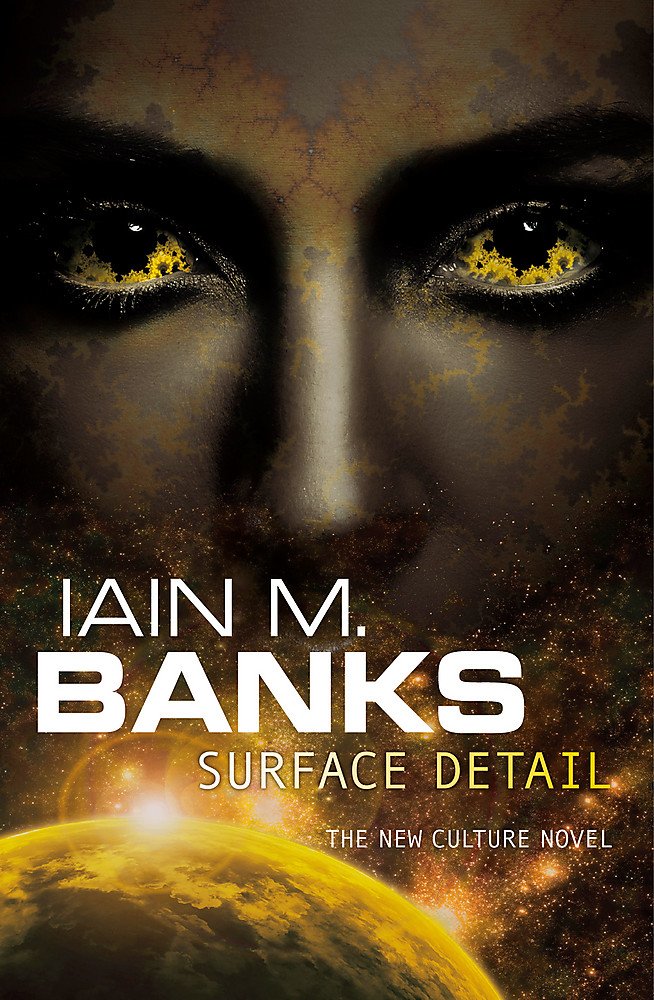Surface Detail

Review
Surface Detail, by , is the ninth Culture book. It follows Lededje Y’breq as she seeks revenge for her own murder, set against the backdrop of a galactic conflict over virtual hells.
Surface Detail continues the exploration of themes raised in Look to Windward—death and rebirth—while diving deeper into questions of mind, consciousness, punishment, and religion. In Look to Windward, the Chelgrians use soulkeepers to copy their mind-states at death, allowing them to enter a heaven created by their sublimed ancestors. Here, other civilizations use similar technology to trap the unworthy dead in virtual hells, where they’re tortured for eternity.
The Plot
The large-scale plot revolves around the Culture’s opposition to these virtual hells and the simulated war—called the War in Heaven—over their fate. The Culture pledged to stay out of the war to ensure fairness, but their position grows increasingly complicated as they realize the anti-hell side is losing.
There are multiple, intertwining small-scale plots that help keep the story moving while giving us a broad view of the conflict. The first is the murder of the slave Lededje Y’breq by her owner, Joiler Veppers. Y’breq is reincarnated in the Culture from a copy of her mind-state and sets off for revenge, eventually joining the Abominator-class Culture warship, Falling Outside The Normal Moral Constraints (FOTNMC).
The second is Veppers’s involvement in the war. Initially, he appears to be a minor player, but it quickly becomes clear that he is pivotal. He manipulates both sides before ultimately revealing his support for the anti-hell faction—an unexpected stance for the story’s main antagonist. It’s revealed that his company supplies the hardware running most of the hells, and his allegiance is entirely self-serving, allowing him to escape soon-to-be-worthless contracts.
The third is the war story of virtual soldier Gyorni Vatueil as he rises through the ranks on the anti-hell side of the War in Heaven. Realizing his side is losing, he escalates the war into the real world by conspiring with the Geseptian-Fardesile Cultural Federacy (GFCF) to launch an attack on the hell servers.
The fourth plotline follows Prin and Chay, two Pavuleans who infiltrate their species’ hell to expose its horrors. Prin escapes, but Chay’s mind is too far gone, and she remains trapped in the hell. Through Chay’s eyes, the reader is shown exactly how terrible these simulated hells are. ’s infamous ability to write gruesome violence brings the horror to life.
The final plotline involves Contact agent Yime Nsokyi, part of Quietus—the branch of Contact that deals with the dead, the reincarnated, and the simulated. She tries to intercept Y’breq but repeatedly fails. Nsokyi’s role in the narrative is mainly as an observer, offering the reader different views of the conflict.
Thoughts
Surface Detail is my favorite Culture novel so far, narrowly beating out Use of Weapons. This is partly because the plot is so engaging, with great action sequences, cliffhangers, and the anticipation—shared by FOTNMC in the narrative—of seeing the Culture join in a full-scale war. But it is also because the characters are so compelling. I wanted to see Veppers ruined and Y’breq take her revenge. I loved the bumbling GFCF, who were just trying to get the Culture to notice them. The psychotic but lovable FOTNMC showed how even ships can have personality. In previous Culture books, I sometimes felt a slight detachment from the characters and settings, like I was watching them from a distance. For reasons I can’t fully explain, Surface Detail pulled me in completely.
A significant twist comes in the epilogue: Vatueil is revealed to be the Special Circumstances agent Cheradenine Zakalwe1 from Use of Weapons, implying that the Culture has been involved in the War in Heaven from the start. It forced me to reconsider what serendipitous events—like FOTNMC’s arrival to pick up Y’breq—were actually Special Circumstances controlling things in the background.
Surface Detail reminded me of several other works:
-
The hacking-as-battle sequences echo The Detective’s Tale from Hyperion. The virtual hells evoke the Shrike and its tree of pain. Vatueil’s battles parallel the soldier’s fight through time against the Shrike.
-
Y’breq’s quantum entanglement transfer recalls how the Bobs create copies in We Are Legion (We Are Bob).
-
The mind backups are similar to the technology in Pandora’s Star, but this book explores the idea that “the backup isn’t you”.
-
notes that the galaxy’s dead outnumber the living, paralleling 2001: A Space Odyssey’s line: “Behind every man now alive stand thirty ghosts, for that is the ratio by which the dead outnumber the living.”
-
The virtual hells are reminiscent of the Star Trek: Deep Space Nine episode Hard Time, where Chief O’Brien suffers PTSD after receiving memories of a 20-year imprisonment.
-
Virtual afterlife and themes of mind and consciousness both feature prominently in Blindsight.
-
The mention of high-gravity species afraid of a millimeter drop recalls Mission of Gravity and Dragon’s Egg.
-
Although not a book, the concept of eternal punishment for mind-states reminds me of Roko’s basilisk and the AI safety movement.
It’s bittersweet to move on to The Hydrogen Sonata, the final Culture book. Before I do, I’m reading Grand Melee, the latest book in the War Horses series.
-
An interesting pattern emerges when you look at Zakalwe’s role in both Use of Weapons and Surface Detail: he’s often placed on the side the Culture wants to lose. In this book, he is planted as a pro-hell mole on the anti-hell side before eventually switching sides. ↩